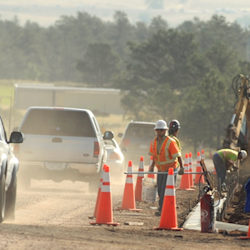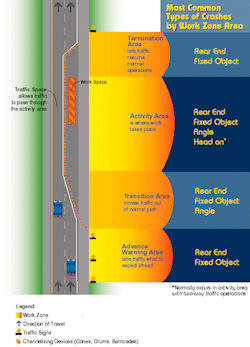Traffic Control Plans
A traffic control plan helps move motorist traffic safety through or around roadway work zones to protect the public and workers. The traffic control plan makes use of traffic control devices, standard signage, and buffer and transition zones. When flaggers will be used on a job lasting more than one day, there must be a current site-specific traffic control plan kept on site.
There are two types of traffic control plans: Temporary and Internal. The type of work you're doing will define exactly which type of traffic control plan you need.
Temporary Traffic Control Plans (TTCPs)
Temporary Traffic Control Plans (TTCPs) are designed to assist road users by providing appropriate visual cues and guidance. In the Temporary Traffic Control zone, construction vehicles and equipment moving inside create a risk to workers on foot.
Activity Area. The Temporary Traffic Control activity area is the section of the highway where the work activity takes place. It is comprised of the work space, the traffic space, the buffer space, and the incident management vehicle storage space. Click on the button below to see more information on activity area spaces.
Spaces within the activity area
- Work Space. The work space is that portion of the roadway closed to traffic and set aside for workers, equipment, and material. Work space may be fixed or may move as work progresses. Long-term work spaces are usually delineated by channelizing devices or shielded by barriers to exclude traffic and pedestrians. the Internal Traffic Control Plan covers safety inside the work space.
- Traffic Space. The traffic space is the portion of the roadway in which traffic is routed through the activity area.
- Buffer Space. The buffer space is an optional feature in the activity area that separates traffic flow from the work activity or a potentially hazardous area and provides recovery space for an errant vehicle.
- Incident Management Vehicle Storage Space. When work occurs on a high-volume, highly congested facility in an urban area, it is optional to allow space to store emergency vehicles (e.g., tow trucks) to respond quickly to traffic incidents.
Actions to consider when developing and implementing a TTCP.
- Restrict personnel access points into work areas and define/designate "no backing zones" and "pedestrian-free zones."
- Design into the Temporary Traffic Control Plan flow paths for equipment and vehicle traffic to minimize backing maneuvers where possible. There should also be buffer spaces to protect pedestrian workers from straying traffic vehicles and/or work zone equipment.
- Establish procedures for entering and exiting the work zone.
- Train all employees on the Temporary Traffic Control Plan and its precautionary measures.
- Facility Closure: full, partial, short term, ramps, approaches, detours, alternate routes
- Reduced shoulder and lane widths to maintain number of lanes
- Reduced length of work zone lane closures or impact area, segmenting work zone
- Lane closure to provide worker safety, increased lateral buffer
- Vehicle restrictions (trucks, oversize, local traffic, etc.)
- Emergency vehicle access
- Emergency pullouts for disabled vehicles or enforcement
Internal Traffic Control Plans (ITCPs)
In contrast to a TTCP, an internal traffic control plan (ITCP) addresses hazards inside the activity area work space of a temporary traffic control zone. The objective of the ITCP is to provide a safe traffic pattern and access plan for the contractor, equipment and materials, and improving the overall safety of the work zone. The ITCP is developed by the Contractor prior to beginning work on the project
The ITCP should include internal haul routes, work zone access points, and should consider the following:
- Reduce equipment back-ups.
- Limit contractor access points within the work zone. Attention should be given to ingress and egress locations.
- Establish pedestrian and worker free areas where possible.
- Establish work zone layouts appropriate for the work type being performed.
- Provide signs within the work zone to give guidance to workers, equipment, trucks, and drivers.
- Evaluate acceleration / deceleration areas.
- Design buffer spaces to protect workers from errant vehicles or equipment.
- Establish a maintenance plan for temporary traffic control devices.
- Brief truck drivers on access and internal paths to follow within the site.
- Review and update the ITCP on a regular basis at project safety meetings throughout the life of the project.
- A designated person monitors and corrects non-compliant behavior.
Knowledge Check Choose the best answer for the question.
1-2. Which traffic control plan is designed primarily to protect workers inside the work space of a work zone activity area?
You forgot to answer the question!


